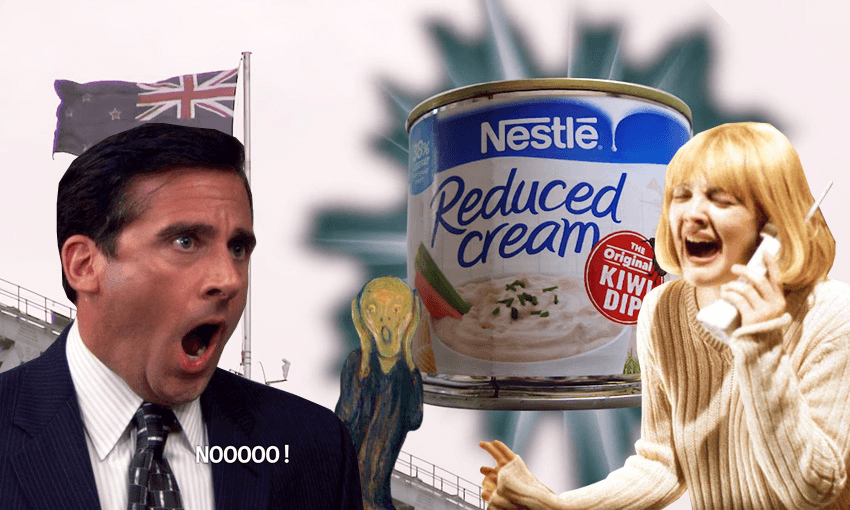For some, it symbolises the very backbone of New Zealand’s food culture. But can Kiwi onion dip survive after the factory that makes reduced cream is shut down?
The Australian factory that makes Nestlé reduced cream, an integral ingredient in Kiwi onion dip, is shutting down, casting a shadow over the future of the New Zealand culinary icon.
The plant, in the town of Tongala in northern Victoria, produces mainly tinned milk products, including reduced cream. The closure will result in the loss of 106 jobs as production is gradually moved overseas during the next 18 months.
Nestlé says reduced cream will continue to be available, but, despite the Sydney Morning Herald reporting that the majority of the products currently made at Tongala will shift to factories in New Zealand, Nestlé has ruled out the possibility of reduced cream being made in its spiritual homeland.
“Production will move overseas, but not to New Zealand,” said Philippa Naylor, Nestlé corporate affairs manager for Nestlé Oceania, via email. “We are still working through the details of which Nestlé factory overseas we will move production to. I’ll advise you of the location as soon as I can.”
The Swiss conglomerate has 449 factories in 189 different countries.
Nestlé reduced cream is currently sold only in New Zealand and Australia, Naylor said. “Milk and cream variants are produced and sold in other countries but this particular reduced cream recipe is unique to Australia and New Zealand.
“We’re determined to ensure that the move is seamless for consumers, and plan to continue producing the products they love,” she added. “That’s why we’ve announced this now – so that we have time to plan properly and have ample time for a smooth transition.”
Despite Naylor’s assurances, the news has struck terror into the hearts of Kiwi onion dip fans, including The Spinoff’s Hayden Donnell. “Holy fuck holy shit what is going to happen to my dip?” said Donnell when he learned of the pending factory closure. “Jesus Christ, what of Rosemary’s legacy?”
Donnell, who has often suggested that Kiwi onion dip should be in Te Papa, embarked on an epic search to find the inventor of this taonga of New Zealand food history, revealing the hitherto unsung hero to be Rosemary Mount, nee Dempsey, in an emotional rollercoaster of a story on The Spinoff in 2017.
Kiwi onion dip, a simple yet delightful combination of Nestlé reduced cream and Maggi onion soup, was invented by Dempsey in the early 1960s in an effort to boost the sales of the latter product. Dempsey was heading up the company’s test kitchen in Auckland at the time.
While Maggi soup launched in New Zealand in 1952, five years after Maggi merged with Nestlé, reduced cream has been produced here for much longer, first at the Underwood factory in Invercargill in the early 1900s. While at first the locally made reduced cream was a rival to Nestlé’s imported version, Nestlé took over New Zealand Milk Products, which owned the factory, in 1938, dominating the market from then on.
In 1965, production of reduced cream moved from Underwood to Nestlé’s new Cambria Park factory in Wiri, South Auckland, where it was made until 1999, when it moved across the ditch to Tongala.
While today many of us might struggle to think of a use for reduced cream beyond the beloved dip, it has not always been thus. In the days before most households had refrigerators, reduced cream offered the benefit of staying fresh for longer as well as being cheaper than regular cream, meaning it could be used more liberally – an important factor in the time of economic hardship that the great depression brought to much of the world, including New Zealand.
Early newspaper ads encouraged serving it with fruit for “a touch of luxury”.
During World War II, reduced cream was included in care packages sent to New Zealand soldiers serving abroad. In 1941, nine dozen tins of the stuff was despatched overseas by the Whangārei District Patriotic Committee in Christmas gift parcels alongside Christmas cake, chocolate, condensed milk, tinned fruit and tinned oysters and whitebait, reported the Northern Advocate. “Tinned pears and reduced cream are fine fare, and reminded me of the old yachting days on the Hauraki Gulf,” wrote Officer Alan Lees of a parcel sent to him in Scotland in a letter published in the Gisborne Herald in January 1945.
The advertising trends shifted from the early 1960s, however, when dips – and Dempsey’s genius pairing in particular – became de rigueur.
Which brings us to the question: what even is reduced cream? The ingredients listed on the can are cream (58%), skim milk, water, milk solids non fat, and stabilisers 401 and 407. Naylor said, “We can’t tell you exactly how reduced cream is made as that’s a secret recipe,” but confirmed the main ingredient was currently sourced from Australia. In future, the cream used would come from whichever country production moved to.
What effect the shift in production – presuming Nestle does find a new home for reduced cream – has on the product remains to be seen, but it’s fair to say Nestlé will be scrambling to avoid the public relations disaster that Cadbury was forced to deal with following the closure of its Dunedin factory last year.
If you’re thinking you’ll just switch to another brand should the Nestlé version go bad, you’re fresh out of luck, sorry. Countdown’s own brand reduced cream has the exact same ingredients as the Nestlé one and the PR team confirmed it comes from the same factory in Tongala – the one that’s shutting down. “Our head of own brand only found out about the changes today. We know very little details but are looking into the matter,” said a Countdown spokesperson.



